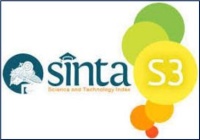Analisis Filogenetik Cryptic species Apis cerana Fabricius, 1793 Berdasarkan Gen 16S rRNA
Abstract
Apis cerana is a member of the Insecta class grouped in the order Hymenoptera. Phylogenetic analysis is used to describe the kinship of living things through phylogeny trees. This study aims to describe the phylogenetic relationship of cryptic species in Apis cerana based on the 16S rRNA gene. Sampling use the cruising method in various regions, the DNA isolation, DNA amplification, sequencing, followed by bioinformatics analysis using GeneStudio, DNASTAR, MESQUITE, and MEGA 11. The result showed that phylogenetic analysis with the Neighbor-Joining (NJ) and Maximum Likelihood (ML) methods produced a phylogenetic tree that illustrates clear evolutionary relationship. A. cerana from Central Sulawesi is more closely related to other A. cerana species in the same clade, while other species are separated. The result of this study show a clear pattern of kinship between A. cerana populations.
Keywords
Full Text:
PDFReferences
Abellan, S.I., Matchado, M.S., Reitmeier, S., Sommer, A., Sewald, Z., Baumbach, J., List, M., & Neuhaus, K. (2021). Primer, Pipelines, Parameters: Issues in 16S rRNA Gene Sequencing. American Society for Microbology, 6(1): 1-22. https://doi.org/10.1128/msphere.01202-20
Aprilianto, V., & Sembiring, L. (2016). Filogenetik Molekuler: Teori dan Aplikasi. Innosain, Yogyakarta.
Bovo, S., Utzeri, V.J., Ribani, A., Cabbri, R., & Fontanesi, L. (2020). Shotgun Sequencing of Honey DNA can Describe Honey Bee Derived Environmental Signatures and The Honey Bee Hologenome Complexity. Scientific Reports, 10(1): 1–17. https://doi.org/10.1038/s41598-020-66127-1
Chauhan, D.S., & Joshi, R. (2024). Effect of Honey Bee ( Apis cerana ) Dominated Insect Pollination on Yield and Quality of Mustard , Buckwheat and Plum in Central Himalayan Agro Ecosystem. International Journal of Ecology and Enviromental Sciences, 5199(4): 543–556. https://ojs.nieindia.org/index.php/ijees/article/view/69
Gao, J., Jin, S.S., He, Y., Luo, J.H., Xu, C.Q., Wu, Y.Y., Hou, C.S., Wang, Q., & Diao, Q.Y. (2020). Physiological Analysis and Transcriptome Analysis of Asian Honey Bee (Apis cerana) in Response to Sublethal Neonicotinoid Imidacloprid. Insects, 11(11): 1–20. https://doi.org/10.3390/insects11110753
Hasam, S., Qarizada, D., & Azizi, M. (2020). A Review: Honey and its Nutritional Composition. Asian Journal of Research in Biochemistry, 7(3): 34–43. https://doi.org/10.9734/ajrb/2020/v7i330142
Jourdan, J., Bundschuh, M., Ciocianu, D.C, Fiser, C., Grabowski, M., Hupało, K., Kokalj, A.J., Kabus, J., Rombke, J., Soose, L. J., & Oehlmann, J. (2023). Cryptic species in Ecotoxicology. Environmental Toxicology and Chemistry, 42(9): 1889–1914. https://doi.org/10.1002/etc.5696
Kamarudin, K.R., Rehan, M.M., Noor, H.M., Ramly, N.Z., & Rehan, A.M. (2016). 16S rRNA Barcoding Technique for Species Identification of Processed Sea cucumbers from Selected Malaysian Markets. Journal of Science and Mathematics Letters, 4(1): 10–23. http://irep.iium.edu.my/58238/
Kurniawan, A., Apriyanti, R., Safitri, A.M., Almaghribi, S.P.N., Syarif, A.F., & Kurniawan, A. (2023). Filogeografi Trigonopoma gracile dari Sungai Gedong, Bangka dan Catatan di Paparan Sunda berdasarkan Gen COI. Samakia : Jurnal Ilmu Perikanan, 14(1): 47–53. https://journal.ibrahimy.ac.id/index.php/JSAPI/article/view/2349
Lamerkabel, J.S.A., Rumthe, R.Y., & Sarkol, M.E. (2023). Species Diversity and Nesting Descriptions of Stingless Bees (Apidae; Meliponini) on Ambon Island. Jurnal Budidaya Pertanian, 19(1): 79–86. https://doi.org/10.30598/jbdp.2023.19.1.79
Mamuaya, T., Samuel, M.Y., & Christine, A.C. (2024). Morphology, Morphometry and Analysis of The COI Gene in Silico Apis dorsata Binghami from Southeast Minahasa. Jurnal Pendidikan Tambusai, 8: 8777–8785. https://doi.org/10.31004/jptam.v8i1.13716
Mas’ud, A., Hasan, S., & Sundari, S. (2023). Identifikasi Jenis Lebah Madu Asal Kepulauan Sula menggunakan Aplikasi DNA Barcode LCO Gen. Jurnal Biosilampari : Jurnal Biologi, 5(2): 163–168. https://doi.org/10.31540/biosilampari.v5i2.1888
Nuraini, N., & Purwanto, H. (2021). Morphology, Morphometrics, and Molecular Characteristics of Apis cerana and Apis nigrocincta from Central Sulawesi, Indonesia. Jurnal Biologi Tropis, 21(2): 368–382. https://doi.org/10.29303/jbt.v21i2.2614
Oktafia, R.E., & Badruzsaufari. (2021). Analisis Filogenetik Garcinia Spp. berdasarkan Sekuens Gen rRNA. Ziraa’ah, 46(2): 259–264. http://dx.doi.org/10.31602/zmip.v46i2.4526
Pangestika, Y., Budiarjo, A., & Kusumaningrum, H.P. (2015). Analisis Filogenetik Curcuma zedoria (Temu putih) berdasarkan Gen Internal Transcribed Spacer (ITS), Jurnal Biologi, 4(4): 8-13. https://ejournal3.undip.ac.id/index.php/biologi/article/view/19424
Rajkumari, P., Krishi, M. B., Kendra, V., Corresponding, I., Rahman, A., & Rajkumari, P., Krishi, M.B., Kendra, V., Corresponding, I., Rahman, A., & Bathari, M. (2020). Morphometric and Molecular Characterization of Eastern Honey Bee, Apis cerana F. Populations in The Northeast Himalayas. Journal of Entomology and Zoology Studies, 8(1): 1273–1280. http://www.entomoljournal.com
Shakya, M., Ahmed, S.A., Davenport, K.W., Flynn, M.C., Lo, C.C., & Chain, P.S.G. (2020). Sandardized Phylogenetic and Molecular Evolutionary Analysis Applied to Species Across The Microbial Tree of Life. Scientific Reports, 10(1): 1–15. https://doi.org/10.1038/s41598-020-58356-1
Subari, A., Razak, A., & Sumarmin, R. (2021). Phylogenetic Analysis of Rasbora Spp. Based on The Mitochondrial DNA COI Gene in Harapan Forest. Jurnal Biologi Tropis, 21(1): 89–94. https://doi.org/10.29303/jbt.v21i1.2351
Taye, R.R. (2020). An Overview on The Diversity, Nesting Behaviour and Importance of Stingless Bees (Hymenoptera; Apidae). Journal of Pharmacognosy and Phytochemistry, 9(1): 529–532. http://www.phytojournal.com
Triandiza, T., & Maddupa, H. (2018). Application of Morphological Analysis and DNA Barcode in Determination of The Porcelain Crab Species (Pisidia Sp.) from The Tunda Island, Banten. Jurnal Sumberdaya Akuatik Indopasifik, 2(2): 81-90. https://doi.org/10.30862/jsai-fpik-unipa.2018.vol.2.no.2.51
Trianto, M., & Purwanto, H. (2020). Morphological characteristics and morphometrics of stingless bees (Hymenoptera: Meliponini) in Yogyakarta, Indonesia. Biodiversitas, 21(6): 2619–2628. https://doi.org/10.13057/biodiv/d210633
Vaamonde, C.L., Kirichenko, N., Cama, A., Doorenweerd, C., Godfray, H.C.J., Guiguet, A., Gomboc, S., Huemer, P., Landry, J.F., Lastuvka, A., Lastuvka, Z., Lee, K.M., Lees, D.C., Mutanen, M., Van Nieukerken, E.J., Segerer, A.H., Triberti, P., Wieser, C., & Rougerie, R. (2021). Evaluating DNA Barcoding for Species Identification and Discovery in European Gracillariid Moths. Frontiers in Ecology ind Evolution, 9(2): 1-16. https://doi.org/10.3389/fevo.2021.626752
Zhang, H., & Bu, W. (2022). Exploring Large Scale Patterns of Genetic Variation in The COI Gene Among Insecta: Implications for DNA Barcoding and Threshold-Based Species Delimitation Studies. Insects, 13(5): 1-11. http://dx.doi.org/10.3390/insects13050425
DOI: https://doi.org/10.33394/bioscientist.v13i1.14967
Refbacks
- There are currently no refbacks.

This work is licensed under a Creative Commons Attribution-ShareAlike 4.0 International License.

Bioscientist : Jurnal Ilmiah Biologi is licensed under a Creative Commons Attribution-ShareAlike 4.0 International License
Editorial Address: Pemuda Street No. 59A, Catur Building Floor I, Mataram City, West Nusa Tenggara Province, Indonesia











